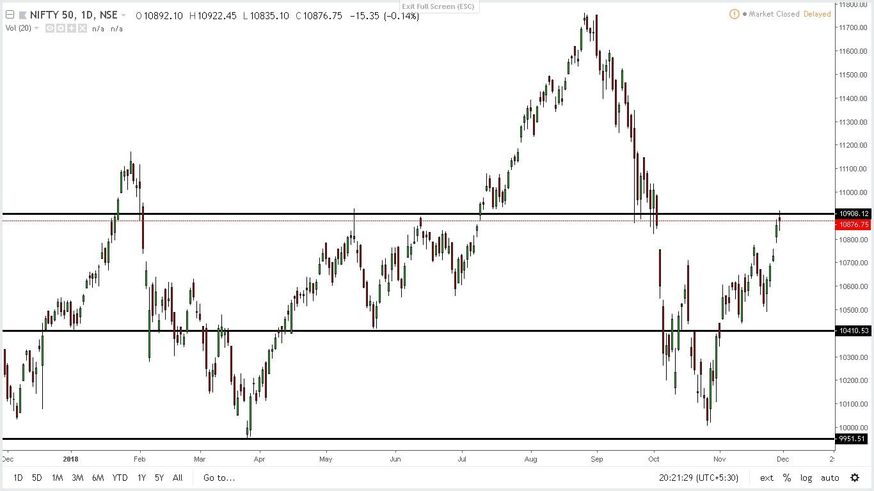TRADING AND INVESTING IN TIMES OF TURBULENCE
|
|
First Interview published on this website ,with a popular author on Trading in stock markets :
INTERVIEW WITH MR INDRAZITH SHANTHARAJ

Indrazith Shantharaj is a full-time trader and Author of “Trade and Grow Rich” book which won Amazon Best Read 2018 award and Editor’s picks 2018 award at Notion Press book store. He is a former IT professional with over 10 years of experience. He has decided to pursue a full-time career in the stock market, which is subject of passion and expertise. His articles can be found at www.profiletraders.in .Apart from trading, he spends his free time travelling to new places, reading books and practicing spiritual sadhana.
"TRADE AND GROW RICH " is Available on-line at AMAZON .IN
ON TRADING AT THIS POINT OF TIME
PP : Market has corrected from historical highs in recent days. For example NIFTY has corrected more than 1000 points from its peak of 11,700. Are you seeing further downside? Is it time now to invest more, withdraw or just wait & watch?
 NIFTY DAILY
NIFTY DAILY
IS : If you look at the Nifty daily chart, Nifty corrected from 11750 levels to 10000 which is over 14% correction in 3 months. It witnessed some bounce from November. However, 11000 level is very crucial for Nifty. I am expecting sideways move between 10200-11000 if #Nifty fails to break 11000 this time. So, one can invest further only if #Nifty breaks 11000 in next week. Else one has to wait for better opportunities in the future.
ON INVESTMENT : TIMING VERSUS SIP
PP : Many of the equity investors are confused over timing of the market or time secular SIP. While one suggests buy on dips and the other on regular time bound contribution irrespective of market condition. Which one is better as per your opinion?
IS : Buy on dips strategy can be applied only to fundamentally strong scripts and in most of the cases, we never know when the fall will halt. In addition, buying the dips does not guarantee any profit. Investors who were buying the dips during any crisis can experience great losses if the price fails to rally on the upside. Buying the dips appears to be most profitable only when the market is oversold. Hence, for an amateur person, regular time-bound investment is a better option.
If you are a technical trader, then one can use any trend reversal technique like Dow Theory reversal or RSI Hidden Divergence etc can be deployed to invest in dips instead of blind investing on dips.
If you are a technical trader, then one can use any trend reversal technique like Dow Theory reversal or RSI Hidden Divergence etc can be deployed to invest in dips instead of blind investing on dips.
WHEN TO EXIT FROM SIP ?
PP : Though SIP eliminates timing of lump sum investment, question still remains "when to withdraw from SIP?” How to solve the riddle?
IS : This is a wonderful question.
Irrespective of reputation, experience, knowledge and education, only “Entry” and “Exit” decide the fate of a trade. Similarly, “Entry” and “Exit” decides the fate (loss or profit) of a long-term investment. With SIP, we are negating the issues with “Entry” by investing the fund at multiple intervals. However, “Exit” still remains as a problem! Before planning an abrupt “Exit” in SIP, one should understand few things about SIP Investment:
SIP investments are for long term. Hence, one should think to exit only in case of emergency or if there is a structural problem with the fund you have invested. Otherwise, it is better to hold these investments as long as possible (then only they can give better returns by using the maximum advantages of compound interest). Always remember it is highly impossible to catch a top or bottom of the market and only two people can catch the market top or bottom. One is god and another one is a liar!
There is a great misconception that SIPs will always generate positive returns. SIPs only help to average out the costs, but the remaining risk with the market will always exist.
Irrespective of reputation, experience, knowledge and education, only “Entry” and “Exit” decide the fate of a trade. Similarly, “Entry” and “Exit” decides the fate (loss or profit) of a long-term investment. With SIP, we are negating the issues with “Entry” by investing the fund at multiple intervals. However, “Exit” still remains as a problem! Before planning an abrupt “Exit” in SIP, one should understand few things about SIP Investment:
SIP investments are for long term. Hence, one should think to exit only in case of emergency or if there is a structural problem with the fund you have invested. Otherwise, it is better to hold these investments as long as possible (then only they can give better returns by using the maximum advantages of compound interest). Always remember it is highly impossible to catch a top or bottom of the market and only two people can catch the market top or bottom. One is god and another one is a liar!
There is a great misconception that SIPs will always generate positive returns. SIPs only help to average out the costs, but the remaining risk with the market will always exist.
TRADING ON ADVICE OF MARKET GURUS
PP : Is it wise for a person, who has small time to be in market, to enter trading based on advice of market gurus? What is your advice to the persons who are ready to take risk, but are unable to spend time? Are mutual funds an ideal solution?
IS : Every big investor/trader starts with a small capital. A stock market is a place which offers unlimited growth along with unlimited risks. So, one should have complete clarity before entering the market. For example, a person is ready to take the risk, but he doesn’t have enough time. Then if he chose mutual funds, he will get an average 10-20% return per year. So, the question is whether the person is happy with this return or not. If not he has to look for other alternatives like fund management etc. However, the risk is always high with this mode of investment if they are unable to find a right fund manager.
My personal opinion is to learn to trade on your own, backtest the concepts/systems and start with a small capital. Once you make a decent return, you can reinvest the profits or increase the capital. It is a bad idea to follow the advice of a market guru blindly as the market is full of gurus and even if you find a genuine guru, his/her holding timeframe is different. For example, if a guru has a bullish view on particular stock for short term, he/she will exit after that short term, but you will end up holding it for long-term which can yield a big loss!
My personal opinion is to learn to trade on your own, backtest the concepts/systems and start with a small capital. Once you make a decent return, you can reinvest the profits or increase the capital. It is a bad idea to follow the advice of a market guru blindly as the market is full of gurus and even if you find a genuine guru, his/her holding timeframe is different. For example, if a guru has a bullish view on particular stock for short term, he/she will exit after that short term, but you will end up holding it for long-term which can yield a big loss!
ON FULL TIME TRADING
PP :What is your advice to the persons who want to trade full -time? What precautions they have to take before leaping?
IS : Trading is the most difficult job in the world as it gives easy money! But like any other profession, it also demands hard work, dedication, and focus. Hence, I always suggest 4 checklists before taking trading as a full-time career:
Zero debts – one should not have any loan or EMI as it will create the unnecessary pressure and will have a huge impact on your trading
Savings – One should have sufficient capital to run the family for minimum one year with the same luxury. For example, if you are spending Rs. 50,000 per month for your family expenses, then you should save minimum Rs. 6,00,000
Trading Results - Trading looks very simple for a beginner when they make some money using a Moving Average (MA). However, the market is always dynamic and one should have the flexibility to tune with the market. So one should make consistent returns from the market before taking trading as full time. For ex, positive returns for three successive months and/or six months income as trading profits
Trading Capital – This is very essential. Suppose if you have the capability to make 10% average returns every month, then you need minimum Rs. 10 Lakh if your monthly expense is Rs 1 Lakh.
I have written a detailed article on this topic on my website as I personally followed this checklist before I decided to quit my well paid IT job.
http://www.profiletraders.in/Pages/Article1?aa=When-To-Become-A-Full-Time-Trader
Zero debts – one should not have any loan or EMI as it will create the unnecessary pressure and will have a huge impact on your trading
Savings – One should have sufficient capital to run the family for minimum one year with the same luxury. For example, if you are spending Rs. 50,000 per month for your family expenses, then you should save minimum Rs. 6,00,000
Trading Results - Trading looks very simple for a beginner when they make some money using a Moving Average (MA). However, the market is always dynamic and one should have the flexibility to tune with the market. So one should make consistent returns from the market before taking trading as full time. For ex, positive returns for three successive months and/or six months income as trading profits
Trading Capital – This is very essential. Suppose if you have the capability to make 10% average returns every month, then you need minimum Rs. 10 Lakh if your monthly expense is Rs 1 Lakh.
I have written a detailed article on this topic on my website as I personally followed this checklist before I decided to quit my well paid IT job.
http://www.profiletraders.in/Pages/Article1?aa=When-To-Become-A-Full-Time-Trader
HOW MUCH TO INVEST IN STOCK MARKET ?
PP :Most of the investments are a compromise of a person between greed and fear. Greed to earn more and fear of losing the capital. In your opinion, what portion of an investment to be deployed in equities which is considered one of the most risky portfolios. ?
IS : Volatility and Uncertainty are part and parcel of equity investing. Higher the risk, Higher the returns. Most traders/investors experience this greed and fear cycle time again and again. This is due to the simple fact that most of them don’t have a plan to manage “Success Rate” and “Risk & Reward” of the trade. So, one has to strike a balance. In general approx 25-50% can be deployed in equities. If you are young you can take more risk by deploying 50% or if you are old, then you can deploy up to 25%
ABOUT INDIRECT INVESTMENT IN STOCK MARKETS
PP : Many of the investments made would have gone to equity, sometimes unknowingly, by way of unit linked insurance, mutual funds, ELSS or SIP. Whether one should consider these investments / contributions also as part of equity investment? Or it should be separated as a long term investment without worrying about the market risk?
IS : Yes, this needs to be considered as part of equity investments. Your overall portfolio value reduces if the market falls. So, one should do the proper diversification across different segments. For example, if the equity market falls, automatically commodity price increases. So, one has to diversify his/her investments across different segments like equity, commodity, real estate etc when the entry price is attractive in that particular segment.
DISCLAIMER :
No content on this INTERVIEW / WEBSITE should be construed to be investment advice. The points of view expressed in the interview are the personal opinions of the interviewee and is not of the website . You should consult a qualified financial advisor prior to making any actual investment or trading decisions. All information is a point of view, and is for educational and informational use only. The website accepts no liability for any interpretation of articles or comments on this blog being used for actual investments.
No content on this INTERVIEW / WEBSITE should be construed to be investment advice. The points of view expressed in the interview are the personal opinions of the interviewee and is not of the website . You should consult a qualified financial advisor prior to making any actual investment or trading decisions. All information is a point of view, and is for educational and informational use only. The website accepts no liability for any interpretation of articles or comments on this blog being used for actual investments.
UPDATED VERSION OF TAX PLANNING FOR FY 2022-23 RELEASED CLICK HERE TO READ
TAX ON RETIREMENT
MORE THAN 2000 VIEWS IN ITS FIRST WEEK OF PUBLICATION
CLICK HERE TO READ
TO KNOW ABOUT UPI PLATFORM , CLICK HERE FOR PRECAUTIONS TO BE TAKEN BEFORE INVESTING , CLICK HERE
|
HAVE CAKE AND EAT IT TOO
Plan your Expenses and Credit Card use , Tweak your Bank Accounts and Earn Extra Income Click Here to read HAVE CAKE AND EAT IT |

